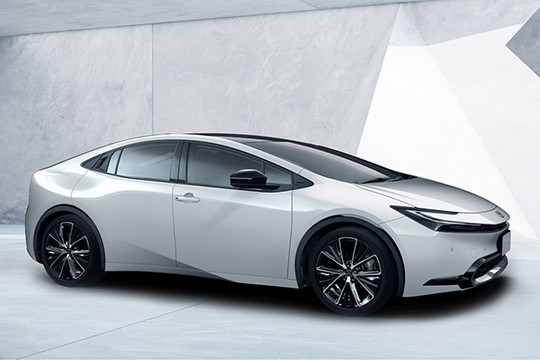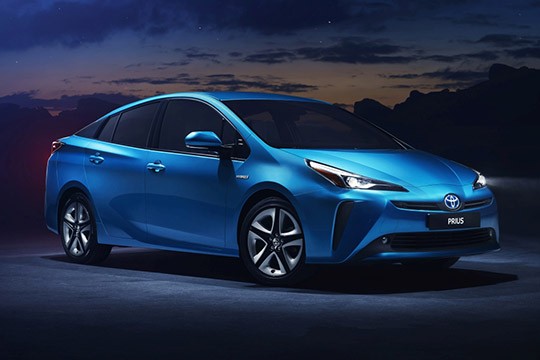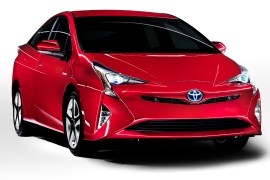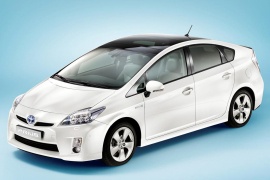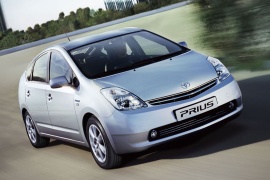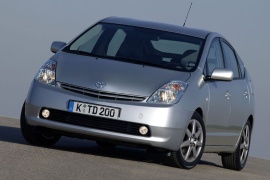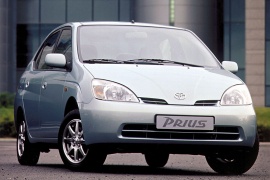TOYOTA Prius Models/Series Timeline, Specifications & Photos
First production year: 1997
Engines: Hybrid gasoline, Plug-in hybrid, Hybrid
Body style: Hatchback
Toyota unveiled the fifth generation of the Prius in late 2022, and the Japanese automaker finally focused more on the car's design, creating a better-looking vehicle.
With a drag coefficient of just 0.26, the 2023 Prius boasted a sleek look with a bold front fascia that featured C-shaped daytime running lights while the headlights were placed underneath them. The profile revealed a raked windshield that could suit better on a sports car. It was continued by an arched roof followed in the back by a sloped rear windscreen in a Kammback-style with a tall rear end. Dropping the unpainted plastics in favor of gloss-black elements helped the car's back look better.
Like its predecessor, the fifth-generation Prius boasted a high-tech interior. After years of placing the instrument panel in the dashboard's center, Toyota finally moved it in front of the driver in the form of a TFT display. In addition, atop the center stack, the carmaker placed a 12.3" touchscreen for the infotainment unit, fitted with a volume knob. Yet, that button was placed on the right side. The Prius featured a center console that hosted the transmission lever between the front bucket seats. Yet, the automaker could have done better with a few buttons or a rotary dial. In the back, the car could accommodate three occupants on the split-folding bench. Yet, the headroom was not something to write home about it.
The car's underpinnings were based on a new hybrid system that relied on a 2.0-liter Atkinson engine paired with an electric motor for a total output of 194 hp (197 PS) in the FWD version. In addition, Toyota also offered two AWD versions, fitted with a 196 hp (199 PS) or a 220 hp (223 PS) powertrain.
Adding an all-wheel-drive system to a car was never a bad idea. But when that happened to one of the most known hybrid vehicles in the world, it's great news.
Toyota has succeeded in promoting the Prius as one of the most important revolutions in automotive history. It was the car that made the hybrid vehicles desirable. Despite its arguable design, it was a big hit. It was introduced in 1997, and in 2015 it launched the fourth generation, which was revised in 2018.
There were not too many things that were modified from the outside compared with the non-facelifted version. The headlights were enhanced with a standard bi-LED system. The taillights used the same technology as well.
The 2015 model was introduced with a somehow outdated infotainment system, but the Japanese engineers fixed that on the 2019 model. All models received a central screen interface. On the 4.2" multi-information display, they added the AWD-e indicator. The color head-up display showed the speedometer, navigation, and hybrid indicator status. All 2019 Prius models, including the Prius AWD-e versions, came standard with Toyota Safety Sense P (TSS-P). It used millimeter-wave radar and a monocular camera sensor to help detect pedestrians, vehicles, and lane markers and headlights in the surrounding area
The drivetrain for the front-wheel-drive versions remained the same. The big novelty was the AWD-e system that powered both axles. While the front wheels were powered via electric and gasoline engine, the rear wheels were powered exclusively by a magnet-less motor controlled by a computer to match the front wheels' speed.
Toyota’s engineers burned the midnight oil and released the fourth generation of the Prius in early 2016 in Las Vegas, and the new model surprised everyone again.
In two decades since the initial model’s launch, the Prius became a phenomenon, with over 3.5 million units sold worldwide. From the ugly-duck-looking first generation to the fourth, it evolved constantly. It started from an embarrassing over-14 seconds acceleration time from zero to 60 mph (0-97 kph) to a decent sub-ten time for the same test. It reached an iconic status, a statement for those who wanted to pollute less and still enjoy their daily commuter vehicle even on longer travels. Toyota revolutionized the automotive industry with its gasoline-electric car, and other automakers had already begun to follow the same steps. However, there was one side that was often overlooked by the automaker: the exterior design. Even though the third generation of the Prius was less bland, it still didn’t shine, and there were few who bought it just because it was an attractive car. With the fourth generation, the Prius started to become exciting not just to look at but also to drive it.
The 2016 Toyota Prius came with a sharper-looking front fascia featuring intriguing-shaped headlights that breached into the bumper. Furthermore, these were using LED technology, which dramatically improved the night driving experience. Its angular styling matched the car’s futuristic look and technology. Like its predecessor, the fourth generation of the Prius had the carmaker’s badge attached to a beak-like element of the bumper, taking a small side of the wide grille. Lower, the automaker placed an additional air intake that ended on the lower side with a lip spoiler.
With its liftback styling and Kamback design, the Prius was instantly recognizable on the streets. However, Toyota pushed even harder on the styling team, which created an ascending shoulder line stretched from the A-pillars to the rear deck. The curved roofline ended in a sloped panoramic rear window, which was already a design signature of the Prius, and Toyota didn’t want to spoil that. However, it chose to upgrade the car’s profile with sculptured doors and an aerodynamic package that included side winglets-type elements in front of the rear wheels. Like in the 2011 model year, the fourth generation of the Prius came fitted with a set of 15-inch alloy wheels as standard, with an option for a set of 17-inch ones. Finally, at the back, the car featured LED taillights with a vertical, blade-like design.
Inside, the TNGA platform used by Toyota allowed the Prius access to multiple enhancements in the interior as well. Besides the longer wheelbase, which resulted in more legroom for the rear-seated passengers, the car boasted a high level of onboard technology. It also featured the TSS (Toyota Safety Senses) bundle that included pre-collision with pedestrian detection, lane departure alert with steering assist, radar-based dynamic cruise control, and automatic high beams. Ever since the Prius’ first generation, Toyota installed the instrument panel in the middle of the dashboard, closer to the windshield, and that’s where it placed it even on the fourth generation of the Prius. In addition, it included a head-up display, which was a relief for those who had trouble looking for numbers on a digital display. In addition, atop the center stack, the car featured a touchscreen for Toyota’s Entune multimedia system with nine JBL speakers as an option.
The 2016 Toyota Prius was powered by an improved drivetrain. Its naturally aspirated 1.8-liter inline-four engine was mated to an electric motor for a combined total output of 124 PS (122 hp). This power source sent its torque to the front wheels via an electronically-controlled CVT (eCVT), leading to an optimized power flow and lower fuel consumption.
Toyota unveiled the European and updated version of the third generation of the Prius at the 2011 Frankfurt Motor Show, and the new version came with significant interior and technical improvements.
In Europe, Toyota Prius faced fierce competition from other carmakers who offered fuel-efficient turbo diesel engines for similarly-sized vehicles. In addition, customers required more high-tech features from such an advanced-engineered car. As a result, Toyota had to adapt and introduce an upgraded car version in 2011. At the same time, it tried to bump the sales figures despite the increased price over its direct competitors with non-hybrid drivetrains. The Japanese automaker sold 200,000 units between 2009 and 2011 in Europe, and some of its customers came from other brands. As a result, the 2011 Prius tried to impress buyers and keep them storming the doors of Toyota’s dealers.
From the outside, there were no significant changes to the car, albeit some were still easy to notice. Up front, the Xenon headlights were available for most grades. In addition, the 2011 Toyota Prius featured standard fog lamps installed in the lower part of the bumper, underneath the daytime running lights. Between them, Toyota installed a broad and rectangular air intake in the apron, while the upper grille was narrow and wide.
From its profile, the steep hood for a compact-sized sedan was continued by the car’s panoramic windshield. A curved roof line and a Kamback-styled rear end completed the image for this aerodynamic vehicle. In addition, the car came fitted with standard alloy wheels across the range, albeit their 15-inch size was nothing to write home about. Still, customers could opt for a 17-inch set that sweetened the deal. Toyota provided the car in eight colors, depending on the grade.
Inside was carefully crafted to fit European customers’ demands. The dashboard and door cards were covered by hard-plastic elements made from recycled materials, but that didn’t bother the Prius’ customers too much. On the other hand, the standard comfortable seats were available with velour or, as an option, man-made leather (SofTex) upholstery. Out back, the flat bench seat was wide enough to fit three adults, and there was just a tiny bump on the floor so that the middle-seated occupant had enough legroom at their disposal. The headroom was also suitable for most people. Behind, the large trunk featured an underfloor storage area. Toyota offered the European Prius a comprehensive package that included seven airbags, ESP, and ABS. In addition, the multi-information display that sat atop the dashboard, closer to the windshield, featured a color display that showed data about the hybrid drivetrain. Atop the center stack, a 6.5-inch touchscreen was standard for most grades, while the top-spec version had a seven-inch one and a head-up display. The golf-club-like shifter from the center console looked neat and easy to use.
Under the hood, Toyota placed a 1.8-liter naturally-aspirated gasoline engine that ran in the Atkinson cycle. It was more efficient than the regular Otto cycle used on most spark-ignited powerplants. It was mated with an electric motor in a parallel system. Depending on the conditions, the car could run on gasoline, electricity, or both. Another improvement over the previous generation was the advanced eCVT (electronically-controlled CVT). In addition, the 2011 Prius was available as a plug-in hybrid. Unlike the regular Prius, it was fitted with a Li-Ion battery that ensured an EV range of 23 km (14 miles).
Unveiled at the 2009 New York Auto Show, the third generation of the Prius surprised its customers not just with its evolved technology but also with a new styling that was far from being bland anymore.
While the first generation of the Prius was the ugly duck of the Toyota family, the third generation came with a surprising design. In addition, it boasted a wide range of technology packages that made customers feel happier with their vehicles. Even though it didn’t provide any sort of brisk acceleration times, it was good enough to merge on the highways without the fear of not being able to emerge onto the first lane quickly. Moreover, since the Prius was already a worldwide phenomenon, it became a statement vehicle for those fighting for a cleaner environment. Unfortunately for the Japanese automaker, the world financial crisis that started in late 2008 affected sales. Despite that, the third generation of the Prius, also known as the XW30, reached more than 1.6 million customers, slightly exceeding its predecessor’s numbers.
At the front, the most eye-catching elements were the swept-back headlights. They featured a double curvature at their upper side as if they were stretched back by an aerodynamic force. Between them, Toyota added a redesigned grille. Furthermore, the carmaker’s badge was moved from the hood to the upper side of the bumper. Lower, in the apron, the automaker placed a rectangular-shaped air intake that complemented the cooling area flanked by stacked fog lamps.
The car’s profile didn’t change too much compared to the Prius’ second generation. Its front side featured a short nose and a raked windshield that almost continued the hood’s ascending line. The greenhouse, on the other hand, was slightly taller but still featured a curved roof. Toyota tried to make the car more aerodynamic and managed to get a Cd of just 0.25 for the 2010 Prius. The Kamback rear end, with a sloped broad rear window complemented by a tiny glass area on the vertical side of the tailgate, helped the Prius achieve that. On the profile, a crease crossed the car’s front to back, making it more attractive. In addition, the car rode on newly designed 15-inch alloy wheels.
Inside the cabin, Toyota reconsidered the overall design and listened to its customers. While the instrument panel remained placed on top of the dashboard, closer to the windshield, the center stack was entirely new. It still featured a touch-sensitive LCD for the infotainment system, but the gear selector was no longer there. Toyota moved it to the center console. The front seats were completely new and featured bolstered areas. In addition, the car had eco-friendly upholstery, giving it an upscale look. At the back, there was plenty of headroom and legroom for three adult passengers. At the same time, the split-folding bench seat could expand the already big trunk space for a compact-sized vehicle.
Under the hood, things evolved dramatically. Toyota ditched the formerly used 1.5-liter powerplant and replaced it with a newer, more potent 1.8-liter unit. The transmission was no longer a simple CVT but an eCVT, which proved to be a better choice for the car’s hybrid synergy drive system. All versions had anti-lock braking systems, traction control, and other safety features. In addition, customers could order the Prius fitted with solar panels on the roof, adaptive cruise control, and a lane-keeping assist system.
Toyota added a mid-life cycle update for the second generation of the Prius in 2005, updating the car’s look and adding a few changes that made the car even more attractive to its customers.
The Prius was already a worldwide phenomenon in the automotive industry. Its revolutionary drivetrain and record-breaking fuel efficiency made customers forget about the bland exterior and unusual interior. Furthermore, more and more automakers started to reconsider their strategies and invested more money into hybrid technologies. However, Toyota needed to stay ahead of the competition and adapt. As a result, after launching the second generation of the Prius in 2003 for the 2004 model year in the U.S., the Japanese automaker returned with a refreshed version for the 2006 model year. At first sight, there were no significant changes, but a closer look revealed the car’s new perks, which made it an even more attractive vehicle.
Toyota didn’t want to dramatically change the car, so only a keen eye for detail could notice the changes made to the exterior of the Prius. At the front, the clear headlights were fitted with high-intensity discharge (HID) bulbs, offering a better nighttime driving experience. The bumper, on the other hand, wasn’t changed, and the same round fog lamps were kept on the lower side, albeit on all versions.
Thanks to its fastback-shaped bodywork, the Prius proved to be a very fuel-efficient vehicle. Its low drag resistance coefficient of 0.26 had its role in that. However, with only a few touches here and there and wider tires, the car could look better. So that’s what Toyota did to improve the car’s aspect. That resulted in a 0.29 drag coefficient, but customers didn’t care too much about that. A longer spoiler on the deck was part of the changes, and the LED taillights that lowered energy consumption were also included for the 2006 model year.
Inside, the most significant upgrade was for the infotainment screen, called Multi-Function Display by Toyota. The LCD had a higher resolution, and that change was highly appreciated by customers. In addition, the automaker included better materials for the cabin, including new upholstery. Another improvement was for the audio system, which gained an AUX-in plug, allowing customers to use their MP3 players to enjoy their favorite music on their travels. The car was already fitted with Bluetooth connectivity, albeit it didn’t support music streaming from mobile phones. Along with the 2006 model year, Toyota also introduced a reversing camera, which showed its image on the multi-function display placed atop the center stack. In the back, the 60/40 split-folding bench seat allowed customers to expand the trunk space.
The 2006 Prius also had significant technological upgrades, including automatic parking. This was offered as an option for specific countries and relied on parking sensors and an electric motor that turned the steering wheel. The driver had to operate the brakes and switch it from Drive to Reverse, though. Toyota offered the Prius with an improved Atkinson-cycle engine that emitted even lower emissions compared to its predecessor. In addition, it was helped by a 50 kW (67 hp) motor fed by a 106-cell NiMH battery pack.
Toyota learned from its mistakes, and when it launched the car’s second generation at the 2003 New York International Auto Show, customers were delighted in many ways.
After seven years on the market, the first generation of the Prius was replaced. Its successor was no longer a sedan but a liftback with a Kammback rear end that looked a little bit better. The design was not the most significant aspect of the vehicle. Toyota focused more on the drivetrain and, unlike the previous generation, on the interior, which was significantly upgraded in all areas. As a result, while the Prius XW10 (first generation) was sold in about 123,000, its successor reached around 1.2 million customers. Thanks to its 0.26 drag coefficient and the improved engine and motor, the XW20 was responsible for making hybrid vehicles popular worldwide. It wasn’t the only gas-electric vehicle anymore, but it reached an iconic status on the market, especially since it didn’t look like any other Toyota.
With a front fascia that didn’t look angry or aggressive, the second generation of the Prius attracted more customers. Its vertical headlights flanked a narrow grille while the carmaker’s badge adorned the hood. Lower, the wrapped-around plastic bumper featured a lower air intake that could host a set of fog lamps, depending on the grade and market.
From its profile, the Prius showed a short and tall nose followed by a panoramic windshield that almost continued in the same line with the hood. Its arched roofline was sloped down towards the back of the vehicle, sporting a raked-forward rear window attached to the tailgate. A tiny duck-tail helped the car get less turbulence behind it and damage the drag coefficient. Out back, Toyota installed a small but broad window under the spoiler. The car came on the market in an era when car manufacturers tried to provide vehicles with clear taillights, and the automaker installed them on the Prius, flanking the trunk opening.
Inside, the Prius was a clear step forward above its predecessor. The wide dashboard looked clean and sported the instrument cluster in the middle, close to the windshield, but with the digits on the driver’s side displayed on an LED screen. Fronting the driver was a redesigned, four-spoke steering wheel with buttons that controlled media and the data shown by the car’s onboard computer. At the same time, atop the center stack, Toyota installed an LCD for the infotainment system that controlled the stereo and the navigation and showed data about the hybrid drivetrain. The front bucket seats were separated by a narrow center console where the automaker installed a pair of cup holders and a storage compartment under the armrest. In the back, there was enough legroom and headroom for two adults, although three could sit there if needed. Behind the cabin, Toyota placed a decently sized trunk.
The second generation of the Prius was packed with technology. In addition to the infotainment and drivetrain, the car was available with a smart key (keyless entry and start), which was uncommon for those times. Its 1.5-liter gasoline engine ran in the Atkinson cycle and was paired with an e-CVT transmission. In addition, the 50 kW (67 hp) motor helped the car get better acceleration times than the previous Prius.
At the 1995 Tokyo Motor Show, Toyota introduced a humble-looking concept car that changed the automotive industry forever, and that model came into production shape two years later: it was the Prius.
The Japanese automaker tried to think outside the box when it made the first generation of the Prius. Its engineers thought that adding an electric motor and a battery pack would lower fuel consumption despite increasing the car’s weight, and they were right. However, developing such a revolutionary vehicle in a world dominated by fuel-efficient turbodiesel vehicles was challenging. The automaker had to ensure that its car wouldn’t pass unnoticed, so it gave it a unique look. While its overall design wasn’t praised by anyone, the technology was unique. It redefined the way cars would be made. Even though it wasn’t such a hit among customers, the Prius was a milestone in the automotive industry. Toyota unveiled the production version in December 1997 at the Tokyo Motor Show.
While Toyota spent a lot of money on developing the drivetrain, the car’s design team didn’t seem to receive too much funding. The Prius’ front fascia looked mundane, to say the least. It featured swept-back triangular headlights that flanked a narrow grille, while the hood featured a beak-like center element where the badge took center stage. Lower, the wrapped-around bumper was body-colored and featured an additional air intake that cooled the AC condenser and part of the car’s electronic system.
From its profile, the first generation of the Prius revealed a sedan-shaped bodywork with a slightly sloped-down roof ended by a broad rear window. The car was fitted with 14-inch alloy wheels wrapped in skinny 175/65 tires. On the left side, on the C-post, Toyota installed an air intake that cooled the battery pack placed underneath the rear bench seat. Finally, at the back, a short and sloped down deck ended the car, while the rear fascia had corner-mounted taillights.
Inside, customers were in for a shock. The driver fronted a large steering wheel and a long stick next to it towards the center stack, which served as a gear selector. Toyota placed a digital instrument cluster close to the windshield in the middle of the dashboard. As a result, it was less expensive to make the car either with a left or a right driving post. Atop the center stack, the Prius had a small, 5.8-inch touch-sensitive LCD that showed various information about the driving modes and even navigation for selected markets. The velour upholstery covered the front bucket seats and the rear bench seat. In the cabin, there was enough room for five adults on short jaunts or four for long travels.
Under the hood was a 1.5-liter inline-four engine paired with a CVT gearbox. An electric motor that worked in parallel mode was also mated to the same transmission. As a result, the car could be powered by any or both of them. Furthermore, it allowed customers to recharge the battery pack while driving, recovering a large amount of energy when it braked and using it under acceleration. As a result, the car’s fuel consumption was small. However, the performance was far from what most other sedans in its class could provide.
